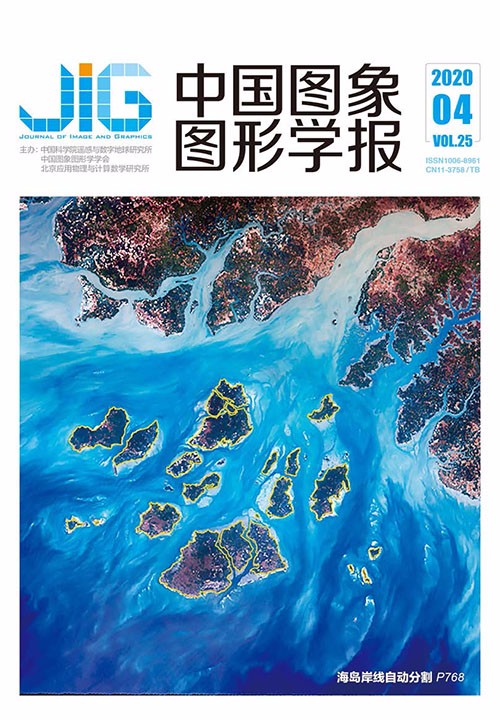
融合区域和边缘特征的水平集水下图像分割
摘 要
目的 水平集模型是图像分割中的一种先进方法,在陆地环境图像分割中展现出较好效果。特征融合策略被广泛引入到该模型框架,以拉伸目标-背景对比度,进而提高对高噪声、杂乱纹理等多类复杂图像的处理性能。然而,在水下环境中,由于水体高散射、强衰减等多因素的共同作用,使得现有图像特征及水平集模型难以适用于对水下图像的分割任务,分割结果与目标形态间存在较大差异。鉴于此,提出一种适用于水下图像分割的区域-边缘水平集模型,以提高水下图像目标分割的准确性。方法 综合应用图像的区域特征及边缘特征对水下目标进行辨识。对于区域特征,引入水下图像显著性特征;对于边缘特征,创新性地提出了一种基于深度信息的边缘特征提取方法。所提方法在融合区域级和边缘级特征的基础上,引入距离正则项对水平集函数进行规范,以增强水平集函数演化的稳定性。结果 基于YouTube和Bubblevision的水下数据集的实验结果表明,所提方法不仅对高散射强衰减的低对比度水下图像实现较好的分割效果,同时对处理强背景噪声图像也有较好的鲁棒性,与水平集分割方法(local pre-fitting,LPF)相比,分割精确度至少提高11.5%,与显著性检测方法(hierarchical co-salient detection via color names,HCN)相比,精确度提高6.7%左右。结论 实验表明区域-边缘特征融合以及其基础上的水平集模型能够较好地克服水下图像分割中的部分难点,所提方法能够较好分割水下目标区域并拟合目标轮廓,与现有方法对比获得了较好的分割结果。
关键词
Level set method combining region and edge features for segmenting underwater images
Sun Yang, Chen Zhe, Wang Huibin, Zhang Zhen, Shen Jie(School of Computer and Information, Hohai University, Nanjing 210098, China) Abstract
Objective Image segmentation is to divide images into homogeneous parts. The level set model is an important method for image segmentation. In theory, this type of models is characterized by the implicit representation of curve evolution, which transforms the image segmentation task into the issue of the mathematical minimization by curve evolution. In recent years, the level set model has been widely used for image segmentation due to its satisfying performance for handling complicated topological changes and has shown good results on ground-based image segmentation. Recently, a variety of feature fusion strategies are introduced into the model framework to stretch the foreground-background contrast to improve the performance on many complicated conditions, such as high noises and several textures. However, different from the ground-based image segmentation, the underwater environment is characterized by the high scattering and strong attenuation factors. As a result, the existing image features and level set models are difficult to be applied in underwater image segmentation. In view of this fact, a region-edge level set model suitable for underwater image segmentation is proposed. Method The representation of the underwater image is often characterized by low contrast and strong noise. The factor of the low contrast makes the objects difficult to be distinguished, which likely causes the weakness among edges. Thus, the region-based and edge-based level set segmentation method degenerated under water. Moreover, the strong underwater noises make the level set model difficult to converge on the object region. To solve the problems mentioned above, our proposed method comprehensively utilizes the region features and edge features of the image to identify the object region in underwater images. First, for the region features, the proposed method introduces the underwater image saliency features into the level set model, and estimates the spatial frequency of the image to identify the object region. For the edge features, this study proposes a novel edge feature extraction method based on depth information, and then extracts the depth deviation from the image to distinguish the object and background, which helps formulate the edge constraint. In the level set function, the edge constraint term is embedded as a weight function to adaptively adjust the weight of the level set constraint to make the model stable. The edge term and the region term cooperate to construct an external energy constraint of the level set model. By fusing the region and edge features, the distance regulation term is introduced to formulate the internal energy term of the level set model, which accelerates the evolution of the level set function and standardizes the level set function to enhance the stability of the level set model. The external energy term and the internal energy term are combined to formulate the final level set function. Result To prove the performance of the proposed method for underwater image segmentation, the proposed method is applied to segment underwater images with low contrast, uneven grayscale or strong background noise, and compare our method with several advanced level set models. At the same time, our methods are compared with several saliency detection methods. The experimental results demonstrate that the underwater object edge is accurately segmented by our method. The proposed method can effectively solve the problems caused by low contrast. In addition, the proposed method is applied to underwater images with strong background noise. Results show that the underwater object and the background are successfully distinguished. Thus, the robustness of the proposed method against underwater strong background noises is proved. Based on the underwater images selected from Youtube and Bubblevision websites, the proposed method outperform several comparison methods in underwater image segmentation. Finally, this study evaluates various methods by using quantitative experiments. Results show that in contrast to the level set segmentation method local pre-fitting(LPF), the segmentation accuracy of the proposed method is improved by at least 11.5%. At the same time, the segmentation accuracy of the proposed method is improved by approximately 6.7% compared with the saliency detection method hierarchical co-salient detection via color names(HCN). Based on the qualitative and quantitative analysis, the proposed method cannot only obtain satisfying results on segmenting underwater images with high scattering and strong attenuation, but also has good robustness against strong background noises. Conclusion In this study, a region-edge based level set model is proposed for underwater image segmentation. The region and edge features of the image are utilized comprehensively and applied to segment underwater images with high scattering and strong noise. For region features, saliency detection is used to stretch the object-background contrast and identify the object region. For the edge features, a novel method is proposed to extract the object edge information, which can solve the weak edge problem caused by the underwater environment. In addition, the regularization term makes the evolution of the level set function stable and robust. Experimental results show that the proposed level set model based on the region-edge feature fusion can well overcome several difficulties for underwater image segmentation. The proposed method can accurately segment the underwater object region and identify the object contour. In contrast to the existing methods, good segmentation results can be obtained by our method.
Keywords
|



 中国图象图形学报 │ 京ICP备05080539号-4 │ 本系统由
中国图象图形学报 │ 京ICP备05080539号-4 │ 本系统由